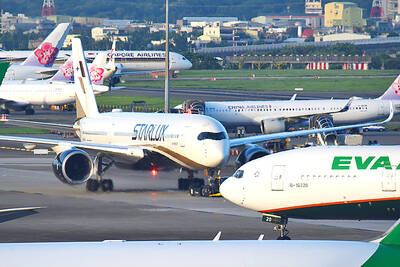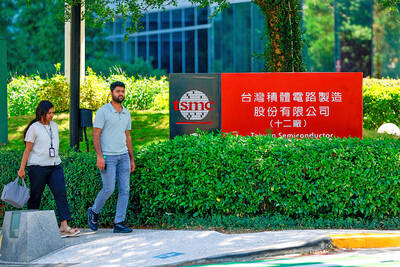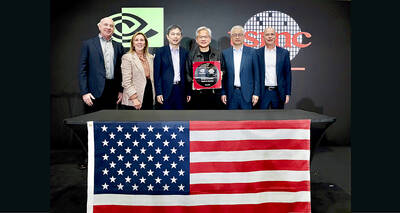YouTube, the world’s most popular video-sharing portal, is experimenting with new business models to increase revenue sources.
“We are making terrific progress in financial terms,” YouTube product marketing manager Michael Rucker told reporters in Taipei yesterday.
Rucker, based in Tokyo, declined to provide specific figures.
The portal is working with movie studios to launch a rental service in which YouTube users would be able to watch full-length movies by paying a fee.
“We are testing the rental service in the US and will see how it goes,” Rucker said.
Another business model the company is working on involves hosting live video streaming on the site, where ads would be displayed simultaneously on the site while a live event is broadcast, he said.
The company’s statement said ad revenues of YouTube’s partners more than tripled last year, although it didn’t offer a comparison base.
YouTube has been posting losses for the past five years and BBC News quoted analysts saying that this year could be the one marking its return to profitability.
Bloomberg News said the biggest challenge facing YouTube advertising was the very approach that has made the site so popular — its user-generated content. Many advertisers are wary of buying ads that might run next to videos that might offend or upset viewers.
Since its first beta version launched in 2005, YouTube viewership has risen to more than 2 billion hits per day. That’s nearly double the number of people who tune in to the US’ three prime-time TV stations combined, said its owner, Google Inc, which bought YouTube near the end of 2006 for US$1.65 billion.
Rucker said YouTube’s vision is to enable users to access its content from any device. Some TV sets, game consoles and smartphones already support playing YouTube videos.
The site is engaged in a continuous effort to help resolve different technology or platform issues related to playing YouTube videos to help realize this vision, he said.
YAHOO
In related news, Yahoo Inc denied that it was suffering an “identity crisis” in the Taiwanese market.
Chief marketing officer Elisa Steele, who is visiting Taipei, was replying to a question from the Taipei Times at a press conference yesterday about whether Yahoo’s global brand campaign titled “It’s You,” launched in October, had managed to revive its stagnant site traffic figures.
The Wall Street Journal recently quoted Steele as saying the campaign was aimed at helping Yahoo launch a “conversation” with netizens and to improve its image.
“Yahoo was in an identity crisis” and the “brand’s health matrix was in a four-year decline,” Steele told the Journal.
Steele defended Yahoo, which is facing competition from major players such as Google Inc and YouTube, by saying the campaign helped stabilize its brand’s health matrix in the US and the UK, while the matrix showed an “upwards trend” in Hong Kong and India.
The matrix includes three measurements: users’ likelihood to recommend the site to friends, whether the site is at the front of users’ minds when using related services and the buzz surrounding the brand in the marketplace.
She said it would not be fair to compare Yahoo with Google from a “product-to-product level,” as what matters is “share of time [of such sites] in the consumer’s mind.”

RECYCLE: Taiwan would aid manufacturers in refining rare earths from discarded appliances, which would fit the nation’s circular economy goals, minister Kung said Taiwan would work with the US and Japan on a proposed cooperation initiative in response to Beijing’s newly announced rare earth export curbs, Minister of Economic Affairs Kung Ming-hsin (龔明鑫) said yesterday. China last week announced new restrictions requiring companies to obtain export licenses if their products contain more than 0.1 percent of Chinese-origin rare earths by value. US Secretary of the Treasury Scott Bessent on Wednesday responded by saying that Beijing was “unreliable” in its rare earths exports, adding that the US would “neither be commanded, nor controlled” by China, several media outlets reported. Japanese Minister of Finance Katsunobu Kato yesterday also

China Airlines Ltd (CAL, 中華航空) said it expects peak season effects in the fourth quarter to continue to boost demand for passenger flights and cargo services, after reporting its second-highest-ever September sales on Monday. The carrier said it posted NT$15.88 billion (US$517 million) in consolidated sales last month, trailing only September last year’s NT$16.01 billion. Last month, CAL generated NT$8.77 billion from its passenger flights and NT$5.37 billion from cargo services, it said. In the first nine months of this year, the carrier posted NT$154.93 billion in cumulative sales, up 2.62 percent from a year earlier, marking the second-highest level for the January-September

‘DRAMATIC AND POSITIVE’: AI growth would be better than it previously forecast and would stay robust even if the Chinese market became inaccessible for customers, it said Taiwan Semiconductor Manufacturing Co (TSMC, 台積電) yesterday raised its full-year revenue growth outlook after posting record profit for last quarter, despite growing market concern about an artificial intelligence (AI) bubble. The company said it expects revenue to expand about 35 percent year-on-year, driven mainly by faster-than-expected demand for leading-edge chips for AI applications. The world’s biggest contract chipmaker in July projected that revenue this year would expand about 30 percent in US dollar terms. The company also slightly hiked its capital expenditure for this year to US$40 billion to US$42 billion, compared with US$38 billion to US$42 billion it set previously. “AI demand actually

Jensen Huang (黃仁勳), founder and CEO of US-based artificial intelligence chip designer Nvidia Corp and Taiwan Semiconductor Manufacturing Co (TSMC, 台積電) on Friday celebrated the first Nvidia Blackwell wafer produced on US soil. Huang visited TSMC’s advanced wafer fab in the US state of Arizona and joined the Taiwanese chipmaker’s executives to witness the efforts to “build the infrastructure that powers the world’s AI factories, right here in America,” Nvidia said in a statement. At the event, Huang joined Y.L. Wang (王英郎), vice president of operations at TSMC, in signing their names on the Blackwell wafer to